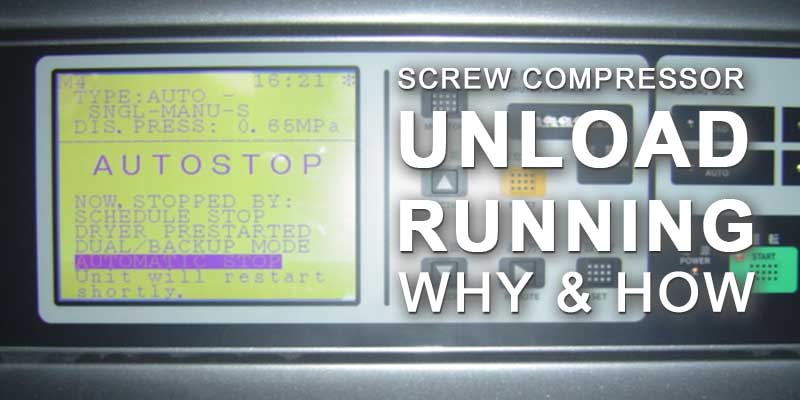
Industrial screw compressor have an operation state called 'unload running'.
In this article we'll discover what this is, why it is necessary and some pro's and con's of unload running.
Pressure regulation
To understand why the compressor is designed with this operating mode 'unload', we must first know how an air compressor regulates pressure.
There are different ways to control pressure, and each way has it's own pros and cons. The main 3 ways that are used in a typical industrial compressed air system are:
- load/unload control
- Modulating (continuous) control
- VSD (speed control)
Since this article is about unload running, we'll focus on the load/unload compressor type here.
Load/unload compressors have two pressure setpoints: an upper setpoint and a lower setpoint. The compressor regulates the pressure between these two setpoint.
When the lower pressure is reached, the compressor starts 'pumping air'. This setpoint is called the 'loading setpoint'.
To avoid an ever-last uncontrolled rise in pressure, the compressor has an upper setpoint, called the 'unload setpoint' - where the compressor stops pumping air.
Due to air usage, the pressure will fall again, until the lower setpoint is reached and the compressor starts up again.
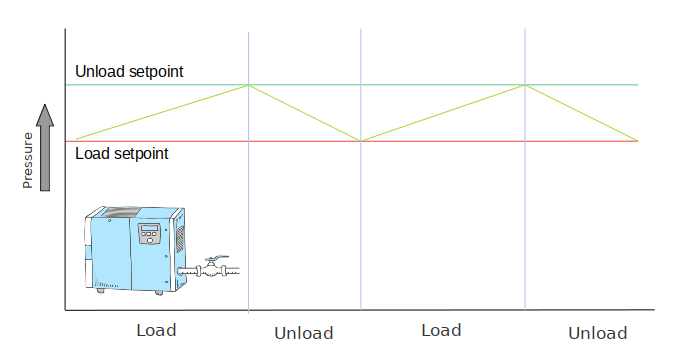 Load/unload example. During unload, no compressed air is produced, so the pressure drops. During load, compressed air is produced and the pressure rises.So, the compressor regulates the pressure in a pressure band by starting and stopping between the lower loading setpoint and the higher unload setpoint.
Load/unload example. During unload, no compressed air is produced, so the pressure drops. During load, compressed air is produced and the pressure rises.So, the compressor regulates the pressure in a pressure band by starting and stopping between the lower loading setpoint and the higher unload setpoint.
Load vs unload vs stopped
Industrial oil-injected rotary screw compressors are at any time at 1 of 3 conditions:
- Loaded
- Unloaded
- Stopped
As explained before, when the lower setpoint is reached, the compressor switches to 'loaded'. When the compressor runs 'loaded', it is actually compressing air and pumping it into the system.
When the upper setpoint is reached, the compressor switches back to 'unload'.
When the compressor runs 'unloaded', it is still running, but it is not compressing any air. It's in 'standby' and the compressed air output is 0.
Load > Unload > Stop
For the reasons outlined above, we try to limit the start per hour and we do this by using the load/unload cycle to regulate pressure and only fully stop the compressor after a certain time of unload running (which means air demand is very low at that time)
For the reasons outlined above, we try to limit the start per hour and we do this by using the load/unload cycle to regulate pressure and only fully stop the compressor after a certain time of unload running (which means air demand is very low at that time)
This typically looks something like this:
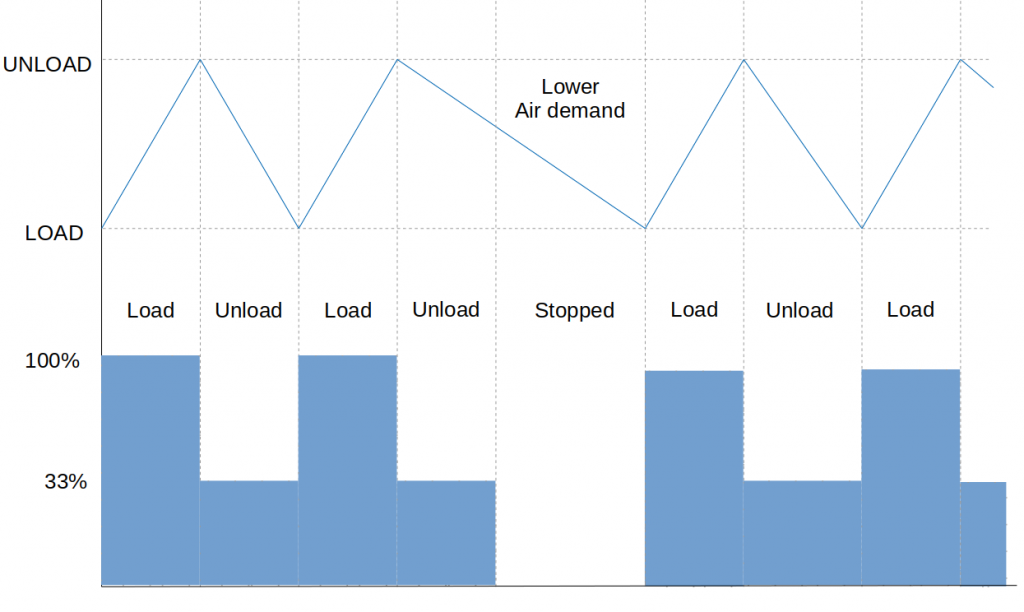 Load/unload stop example. The compressor will only stop when the pressure stays above the lower pressure setpoint (loading setpoint) for a set amount of time.### Why not just stop?
Load/unload stop example. The compressor will only stop when the pressure stays above the lower pressure setpoint (loading setpoint) for a set amount of time.### Why not just stop?
Load/unload air compressors do stop - but only after a set time of unload running.
The load/unload cycle in a typical compressed air system will last anywhere between 10 seconds and a few minutes (or longer), depending on a lot of factors (compressor capacity, air demand, air receiver size, pressure setpoints).
Industrial screw compressors are big machine, starting typically at 5 kW motor power, all the way up to 1000 kW and more.
Unlike those cute little piston workshop compressor, industrial screw compressors can't simply be started and stopped all the time to control pressure.
Starting and stopping often brings the following problems:
1. Timing: to start up an air compressor takes at least 10 to 20 seconds. This time is often too long to accurately control pressure - since the pressure will drop below the setpoint during that time.
2. Motor overload - it takes a lot of power to start up a compressor - if constantly starting and stopping, electric motors and electric controls (contactors, cables) will overheat.
3. Bearings. Starts and stops and the worst for bearing - since there is no oil pressure film built up, there is direct metal to metal contact during these times.
For these reasons, there are limits to how many starts we can do per hour.
How is unloading done?
How do we 'unload' an air compressor? We do that by closing the air inlet. And this is done by the.. inlet valve. Also called the 'unloading valve'.
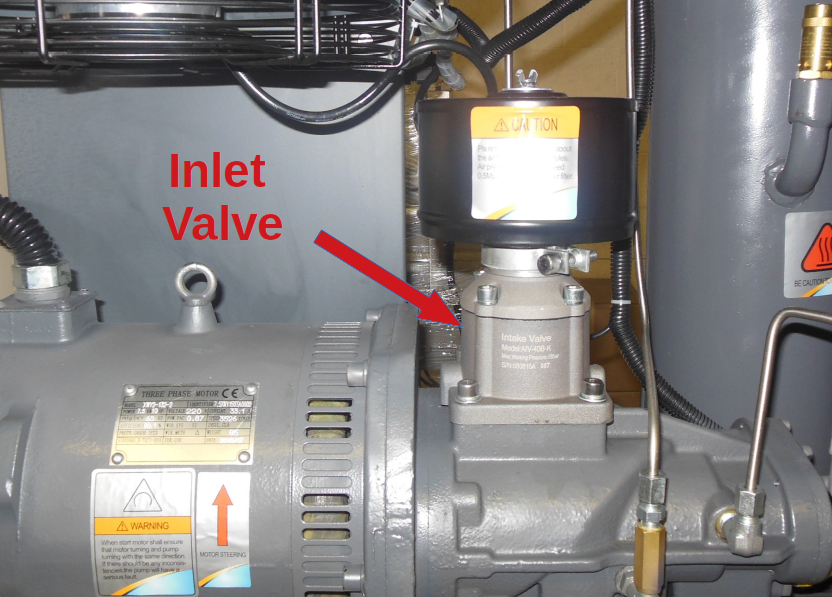 Example of an inlet valve. The inlet valve is situated between the inlet air filter and the screw element - it is bolted directly on the screw element.
Example of an inlet valve. The inlet valve is situated between the inlet air filter and the screw element - it is bolted directly on the screw element.
With this valve open, air can be sucked in and compressed. With this valve closed, no air can be sucked in and the compressor output is reduced to 0 (what comes in must come out - with no air in, there is no output).
The inlet valve is usually pneumatically controlled by a solenoid valve and control air pressure.
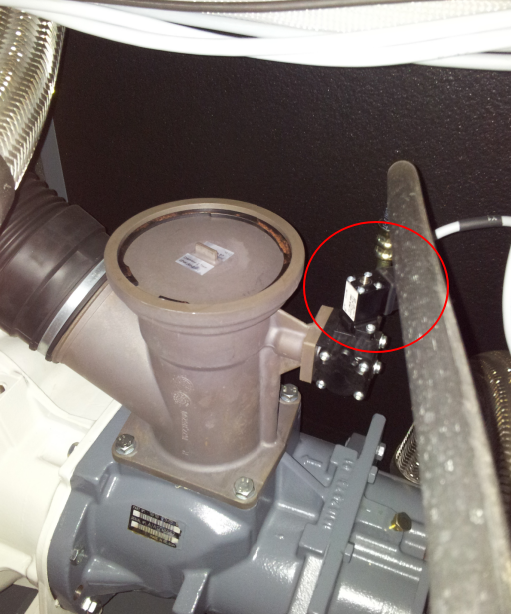 Control solenoid valve
Control solenoid valve
Unload conditions
Let's see what happens when the compressor runs unloaded.
The inlet valve is closed, there is no air sucked in and the compressor output is 0.
A strong vacuum is created between the closed inlet valve and the 'sucking side' of the screw element.
But, the internal pressure is kept at a minimum required internal unload pressure. This pressure is normally between 2.5 and about 3.5 bar.
This is the internal pressure inside the compressor when it is running unloaded with inlet valve closed.
Internal unload pressure
Why is this internal unload pressure needed? Can't we just let it go to 0 during unload, since we are not really doing anything?
This internal pressure is needed for two reasons:
- To keep the oil circulating
- For control air
The main reason is the circulation of oil. Screw compressors don't have a separate oil pump. The oil flows around due to internal pressure differences between the screw elements inlet side and outlet side.
During unload, we have to maintain a minimum pressure to keep this oil flow going!
How is this internal pressure maintained?
There is a small hole, or bypass in the inlet valve that allows the screw compressor to suck in a little bit of air.
This air is used to maintain a minimum internal unload pressure.
To keep this internal unloading pressure constant, the same amount of air that is sucked in is also blown-off. For this purpose there’s a blow-off valve/opening.
A balance is creating by the air input and the blow-off and the pressure settles around a value - dependent on the calibration of these holes. This small, constant flow of compressed air is very important to keep the oil flowing around during unload.
During loading, this blow-off is closed (it would be a waste of compressed air and reduce the overall efficiency of the machine). During unload, this blow-off is opened.
Minimum pressure valve
At the outlet of the compressor we have the minimum pressure valve. This valve typically opens only above 3.5 bar. So during unload running, it is closed.
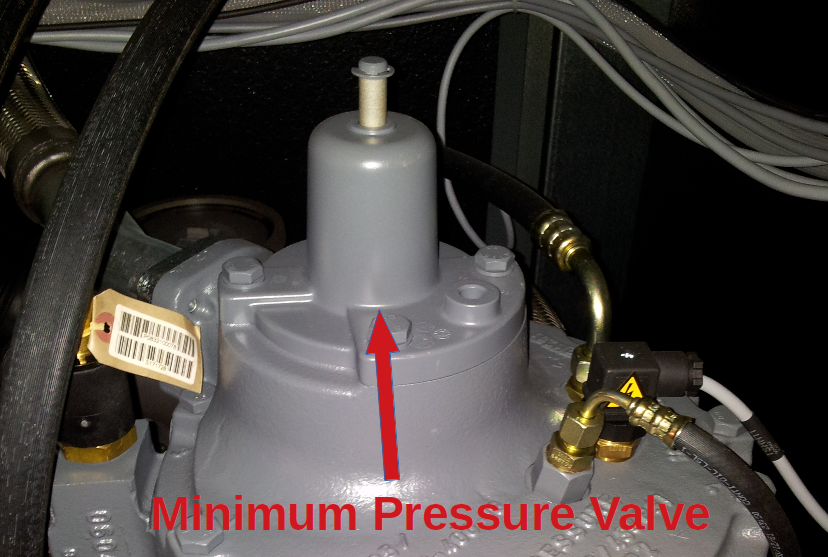 Minimum pressure valve.
Minimum pressure valve.
This valve has two functions when running unloaded
- it prevents compressed air flow back from the piping system (the pressure in the piping system will be higher, at around 7 bar typically).
- it prevents the internal pressure from 'flowing out' when not connected to any system (free flow output), or when the pressure in the piping system is very low.
(the minimum pressure valve has a third function when running loaded: it protects the oil separator, but more on that in another article).
Why lower unload pressure?
Of course, we could also simply close the inlet, and make the system so that the compressor is not actively pumping air, but the internal pressure of the compressor stays constant at the normal output pressure, around 7 or 8 bar.
Why do we lower the internal pressure during unload?
This is done to save energy.
Energy use
The higher the output pressure of an air compressor, the higher the energy use. This is also true for the internal unloading pressure.
The lower the internal unloading pressure, the lower the unload energy use.
Typically, the unload power consumption is about 1/3 of the full-load power consumption.
The overall unload energy use plays a large role in determining the overall efficiency of a compressor installation.
The internal unload pressure and unload energy use is fixed, but we can focus on minimizing the *time* a compressor runs unloaded.
The longer a compressor runs unloaded, the more energy is wasted.
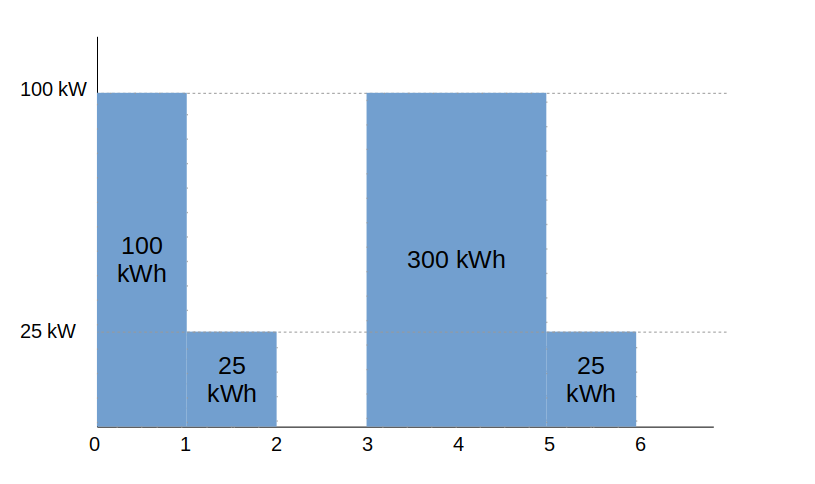 Energy use example with different load/unload times.
Energy use example with different load/unload times.
kWh is the total energy use during the period. The unload power in this example is 25% of full load powerThere are many strategies we can use to minimize the unload running time. For example, adjusting pressure setpoints, increasing air receiver size, making use of a central controller/sequencer, or even installing a smaller air compressor!*
Huge energy savings can be made (think 10 to 100 thousand US$ per year) with just optimizing the unload running times of air compressors.
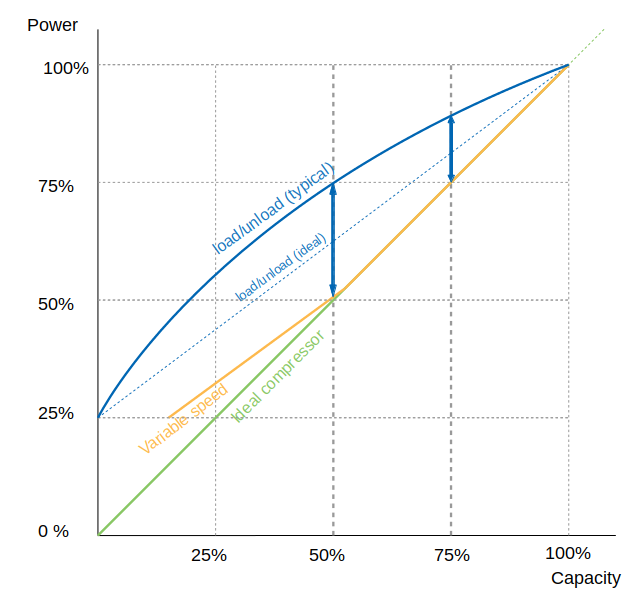 Example for an ideal compressor
Example for an ideal compressor
For an ideal compressor, the power used has a 1:1 correlation to the compressor capacity. For load/unload compressors this is not the case: lower than 100% capacity means increase in losses (blue lines vs green line).
To learn more about this, and other ways to save money on compressed air, get my book "Compressed Air is Money". It will teach you everything you need to know to completely optimize your compressed air system - and save tens of thousands of dollars per year on energy costs.
There are many more ways to save money on compressed air. Roughly these can be categorized as
- Lower air demand
- Lower pressure
- More efficient production
The unload running discussed in this article falls in the category "more efficient production" (although the actual air demand in relation to the compressor capacity plays a significant role here as well).
For more info, click here

Comments
Very interesting. thanks!
Log in or create an account to make a comment...